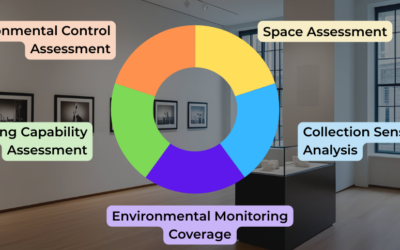Water is a vital substance to all known forms of life on this planet, and a key ingredient in the production of many cultural heritage materials. Think of the large amounts of water that are required to make paper or tan leather. However, water damage can also wreak havoc on collections in all its forms: solid, liquid, and gas. “Water” as an agent of deterioration refers largely to liquid water but can also refer to water in its solid form: ice. Atmospheric water is covered in the agent of deterioration “Relative Humidity,” which allows for a more in-depth exploration of water as an agent in the atmosphere (Tremain 2018).
Watch out for water damage
Water can cause mechanical, chemical, and biological damage to collections. These types of deterioration are not mutually exclusive and are often in combination when caused by exposure to water.
Mechanical deterioration refers to an undesirable change in the physical structure of an object. Mechanical damage caused by water is most often the result of materials taking on and retaining water, or the strain of absorbing and then desorbing that water.
Examples of this type of mechanical damage include cockling paper, cracking or warping wood, and even the cracking of architectural finishes like plaster. Water is absorbed and then desorbed from the material, causing it to swell and then shrink in a manner that can cause cracking, warping, or other distortion. In the case of collections exposed to freezing temperatures, mechanical damage may be the result of liquid water expanding as it freezes. In addition to mechanical damage caused directly to collections, many materials like paper and textiles become weaker when wet, which can lead to damage caused by improper handling in response to a water event (Ford et al. 2012).
Chemical deterioration refers to an undesirable change in the material on a molecular level. Water is an important ingredient in many chemical reactions that lead to degradation including the corrosion of metal and the breakdown of cellulose acetate film (vinegar syndrome).
If water moves through building materials like stone or plaster, it can solubilize minerals and bring them to the surface where they may crystallize causing efflorescence and or spalling. These reactions are often irreversible, which means controlling exposure to moisture is an important aspect of preventing damage (Ford et al. 2012).
Biological deterioration refers to undesirable changes to collection materials by biological organisms like insects and mold.
The presence of liquid water hugely increases the risk of both pest and mold infestation, which can affect large portions of collections and can be very costly and difficult to deal with. It is for this reason that wet and or damp collections should be dried or frozen within 48 hours of a water incident to prevent mold growth (Florian 1997).
Water risk assessment and mitigation
Because of its ubiquity, water damage can come from a myriad of sources.
Three common sources of water that affect collections include weather, building systems, and incidents or spills.
It is important to keep in mind that water from these sources is never pure and could be contaminated with anything from sewage to solvents. Use appropriate personal protective equipment (PPE) when handling any wet collection object.
Extreme weather
Extreme weather events like storms and hurricanes are obvious water risks. Collections stewards can reduce the risk of damage caused by these events by engaging in risk assessment and mitigation. For example, a collections steward may learn that their collection is located in an area that is at risk of infrequent but severe rainstorms, which puts them at risk of flooding. That organization may then mitigate the risk of flooding by engaging in flood preventing landscaping or creating a schedule for clearing drains and gutters. Resources like the National Risk Index can help collections stewards identify the risk of different natural hazards based on their geographical location.
Building systems fail
Building systems and their failure are also big contributors to water damage in collections.
Common issues like leaky roofs, leaking or frozen pipes, and malfunctioning HVAC systems can result in unexpected problems.
These types of events can be prevented through routine building maintenance. In addition to scheduling maintenance for the building envelope and HVAC system, do regular walkthroughs of collections spaces to look for signs of leaking pipes and stained ceiling tiles. Sprinkler systems should also be regularly inspected.
Water spills
The third main source of water damage in collections is spills and accidents. Restricting food and beverage in collections spaces is a good risk mitigation strategy in this case. If collections spaces are included in programs or events where liquids may be present, make sure there are policies and procedures in place to prevent spills and check for them after the fact (Tremain 2018).
Additional tips for generally reducing the risk of water damage to collections include:
- Storing objects at minimum 4” up off of the floor and 18” from sprinkler heads
- Storing objects in enclosures made from non-reactive and supportive storage materials
- Using water detectors in areas prone to flooding
- Winterizing historic buildings
Emergency preparedness and response
The nature of the common sources of water and the level of damage they can do to collections mean that water events are often considered collection emergencies, and for good reason.
Wet or damp collections can deteriorate rapidly and a fast response can mean the difference between no damage and complete loss.
The best way to protect collections from loss and damage caused by collection emergencies is the practice of emergency planning. A good emergency plan should include a communication plan with up to date contact information, concise response plans for different types of emergencies, procedures for collections salvage, guidelines for long-term recovery, and appendices with things like maps and contact information for contractors and conservators. Effective emergency management is cyclical, meaning the response to one emergency should inform the planning for the next. There are many resources available to those engaging in emergency planning. The American Institute for Conservation (AIC)’s Emergency Committee maintains a peer reviewed list of emergency preparedness and response resources using the reference management tool, Zotero.
Key takeaways
- “Water” as an agent of deterioration refers mainly to liquid water and sometimes ice
- Water can cause mechanical, chemical, and biological deterioration and these are often in combination with one another
- Three common causes of water damage in collections are weather events, building issues, and accidents/spills
- Emergency preparedness and response planning is the best way to prevent water damage to collections
Works cited
Florian, Mary-Lou E. 1997. Heritage Eaters: Insects & Fungi in Heritage Collections. London: James & James.
Ford, Patricia, Peter Herzog, Jeremy Linden, James Reilly, and Kristin Smith. 2012. IPI’s Guide to Sustainable Preservation Practices for Managing Storage Environments. Version 2.0. Rochester: The Image Permanence Institute.
Tremain, David. 2018. “Agent of Deterioration: Water.” https://www.canada.ca/en/conservation-institute/services/agents-deterioration/water.html.
Further reading
Dorge, Valerie, Sharon L. Jones, and Getty Conservation Institute, eds. 1999. Building an Emergency Plan: A Guide for Museums and Other Cultural Institutions. Los Angeles: Getty Conservation Institute.
“Health and Safety After Floods.” n.d. National Heritage Responders. Accessed December 11, 2020. https://www.culturalheritage.org/docs/default-source/resources/emergency-resources/tips-sheets/health-and-safety-for-the-public-tip-sheet.pdf?sfvrsn=a9a0120_2.
Refrigerating and Air-Conditioning Engineers American Society of Heating. 2019. “Chapter 24: Museums, Galleries, Archives, and Libraries.” In ASHRAE Handbook: HVAC Applications.
Hear more from Maddie Cooper, preventive conservator, in the Conserv Community.
If you have any questions about environmental monitoring, integrated pest management, or just want to talk about preventative conservation, please reach out to us! Don’t forget to check out our blog or join our community of collections care professionals where you can discuss hot topics, connect with other conservators or even take a course to get familiar with the Conserv platform.





